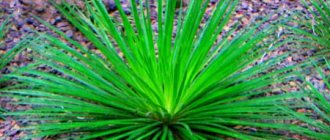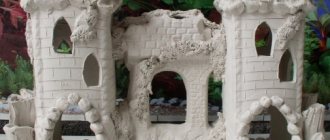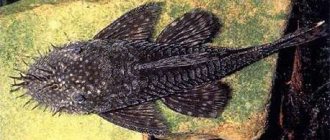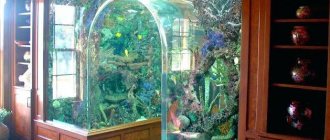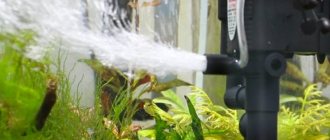Novice animal lovers incorrectly believe that aquarium turtles can withstand any conditions, making a lot of mistakes when arranging their habitat. Divided into land, sea and freshwater creatures, these reptiles have completely different habits; before buying an exotic pet, you need to study all the nuances of its behavior.
Varieties of dwarf turtles for home keeping
Pets always remain miniature. The average length does not exceed 13 cm. Types of domestic aquarium turtles:
- Musky. Remarkably adapts to keeping in domestic conditions, is resistant to numerous infections, reaches 10-11 cm.
- Bolotnaya. Originally from Europe, reaches 10 cm, sometimes lives up to 50 years. This non-exotic species lives in large numbers in European reservoirs. Sometimes it shows aggression; you need to hold the individuals by the top of their shell.
- Spotted - easily recognized by yellow spots throughout the body. Grows up to 9-10 cm, suitable habitat: 50% water, 50% sand, they need large stones and branches.
- Pondovaya - found in Japan, China, and other eastern countries. It is distinguished by square patterns on the shell, gets sick a lot, does not adapt well to our environment, reaches 11-12 cm.
- Closed species native to America and Africa reach 11-13 cm, depending on the subspecies.
- Flat - grows up to 79 cm, feels great in small aquariums, consumes vegetation, is undemanding in care. Some turtles are mistakenly mistaken for dwarf turtles and reach large sizes.
- The red-eared slider is a popular species among pet reptile enthusiasts. This species is distinguished by its endurance; it is recommended to buy them if a person gets a reptile for the first time; due to the inexperience of the owners, they often die. Pets spend a lot of time under water; the sand should always be illuminated with ultraviolet light.
Red-eared breeds are fast, strong, sometimes show aggression, often attack other reptiles and take food from them.
It is convenient to keep them in an enclosure for people who are allergic to animal fur. When buying pets for children, all responsibility rests with the parents. If you properly care for them, their lifespan is extended to 20-40 years.
Natural habitat conditions include:
- Fresh water.
- Space for heating.
- Plants for the nest.
- Warm.
- Sand or silt at the bottom.
Turtles love to lie on top of each other and bask in the sun.
Red-eared fish are difficult to confuse with other species. A stripe of color runs down the neck from the eyes. The top of the shell is smooth, covered with yellow, black and green stripes. The shell is brightly colored, has a greenish tint, and gradually darkens. Over the years, spots are eliminated, the stripes on the neck fade.
The length of newborn individuals is 2.5 cm, after a year they increase to 5-7 cm. Puberty in males occurs when they grow to 10 cm, and in females - at 12.5 cm. The average dimensions of an individual - 25-30 cm - vary depending on living conditions.
Size does not always accurately indicate age; in domestic conditions they increase more quickly than in nature due to overfeeding and almost ideal conditions.
This breed has well-developed senses, the color spectrum is clearly distinguishable even under water, and suitable places for laying are easily determined. At a distance of 40 m they can detect the movement of other individuals or predators. A keen sense of smell helps to search for food, and the sense of touch allows you to choose tastier foods. Red-eared animals have poor hearing and can only recognize vibrations or muffled sounds. The shell contains nerve fibers, so it is sensitive to touch. The animal hisses, snorts, and squeaks.
Pygmy turtles – do they exist?
Dwarf means very small. Is there such a turtle in nature? It may be a shame, but such reptiles do not exist. And even if you are offered to buy a dwarf turtle, the size of which does not exceed three centimeters, you should know that this is an absolute deception; this species does not exist in nature. Many unscrupulous sellers, and sadly, even in pet stores, pass off baby red-eared turtles as pygmy turtles. And under favorable conditions and a balanced diet, the baby grows up to twenty centimeters. Therefore, it is hardly appropriate to call them dwarf.
The smallest turtle in the world is the Pennsylvania turtle, with a maximum length that does not exceed twelve centimeters. But it lives exclusively in shallow rivers and lakes of eastern America. That is, it is a freedom-loving reptile that lives in natural conditions.
Among aquarium turtles there are also small specimens. Their length varies from six to thirteen centimeters. Reptiles whose size exceeds the designated boundaries are large species and require slightly different maintenance conditions than small turtles. In total, there are several types of small-sized turtles that are perfect for aquarium keeping - these are:
- Flat turtles, their weight is only one hundred to one hundred and seventy grams, their length is about eight centimeters. They do not require much space, so a small aquarium will be enough for them. The main food is moisture-loving plants. They are very popular among lovers of exotic pets because they are very easy to maintain;
- Trailing turtles grow to a maximum of thirteen centimeters. Their homeland is North America and Africa. Represented by four subspecies;
- Musk turtles are also popular as pets. Their size varies between fourteen and fifteen centimeters. Taking care of them is not at all difficult. This miniature turtle comes in four species;
- Spotted turtles are an amphibian species. To keep them at home, an aquaterrarium is required, since both water and land are required in equal proportions. The size of turtles reaches thirteen centimeters;
- Chinese three-keeled turtles are also miniature species, measuring about thirteen centimeters in size. They feel great in small aquariums.
These are, perhaps, all the small turtles that exist in the world and are suitable for home keeping in aquariums.
Therefore, if you are offered to buy a dwarf turtle without specifying its type, then most likely you will be disappointed in the future, since the reptile will grow up and you will have to radically reconsider the conditions of its maintenance.
As we have already said, babies of the red-eared turtle, which is also popular among breeders of ornamental reptiles, are most often passed off as a dwarf species. And if the purchase has already taken place, then you shouldn’t be upset, because these turtles are also beautiful, so it offers detailed information on how to properly care for your pet so that it fully develops and pleases its owners for many years.
Caring for Miniature Turtles
Most of the time they sit in the water. Before purchasing a pet, an aquarium is equipped - it can catch a cold and should not walk around the premises. To maximize lifespan, you must follow the care instructions:
- The aquarium is 3-5 times larger than the size of the pet - it needs more free space.
- Half of the bottom area is filled with water.
- In order for the reptile to alternate living on land and in water, large stones and thick branches are placed at the bottom.
- The ultraviolet lamp helps supply the body with calcium.
- Sand is poured onto the bottom, but changing water in such conditions is difficult.
- Suitable air temperature is 28 degrees.
- Fresh water is poured once a week to prevent the spread of infection, and hands are washed.
- Artificial plants are laid out at the bottom, which pets gradually eat.
- Food container is not installed.
Aquarium volume – 100-150 l. A small terrarium is suitable for land breeds. A certain temperature of water and air is suitable for each species. It is necessary to clarify this information with the seller. Violation of the conditions of detention greatly affects the well-being of the turtle.
Not everyone gets large reptiles, since it is difficult to maintain their normal existence and choose the right soil. An aquarium filter helps purify the water.
Classification:
- External.
- Internal.
The design of the external device is similar to a canister with a pump located outside the aquarium. The housing consists of a pair of compartments with filter material. The tubes are connected to the liquid in which the turtle lives.
The internal ones are not so large, they are equipped with pumps and diffusers, and they remove dirt perfectly. The liquid is filtered by a tube and cartridge, coals and other devices. The product is fixed in different positions.
Required components for an aquarium:
- Priming.
- Artificial pool.
- Backlight.
Reptiles living in hot Asian countries love temperatures of 30-40 degrees, the Libyan breed loves warmth very much. Ultraviolet radiation has a positive effect on the body and allows it to absorb vitamin D.
How is gender determined? Puberty begins at 1 year, you can determine whether it is a female or a male after the size of the reptile reaches 10 cm, after 2-3 years you can say for sure who it is. With good feeding, puberty occurs before the age of 1 year.
Girls are larger than boys, their tail is shorter, and the cloaca is closer to the spine. Males have long and curved claws and a concave plastron.
Sellers often keep pets in poor conditions; after purchase, it is recommended to take them to a veterinarian to check for wounds, diseases and other problems. When replenishing the terrarium, newcomers must be kept in quarantine for about 3 months. Adults and young animals are kept separately, as they can injure each other. Living together is suitable for reptiles that are similar in size and requirements.
Adaptation to a new place takes 2-3 days. During this period, there is mild lethargy or abnormal activity.
People hold them in their hands with caution; if they resist, they often drop them. Bites cause pain, sharp claws can scratch the skin, so they do not cause discomfort when touched
Care and maintenance
The red-eared turtle, although not a dwarf turtle, is a fairly popular pet. The size of an adult reptile reaches twenty, in rare cases, twenty-five centimeters. With proper maintenance, a turtle will live in a family for about thirty years, and there are cases when a reptile lives up to fifty, but this is under ideal conditions. In order for a pet to feel good and develop properly, it needs to create favorable living conditions.
A turtle needs a spacious aquarium to live. The optimal volume is one hundred fifty to two hundred liters. And this despite the fact that in childhood the red-eared turtle is only about three centimeters in size. There is a natural pattern: the larger the space, the more fully the reptile develops and grows.
Despite the fact that the turtle is an aquatic reptile, it requires land. Therefore, in the aquarium it is necessary to provide a hill made of stone or other artificial objects that will act as land, where the turtle will go to rest and warm up. At any time of the year, an ultraviolet lamp should be constantly located near the aquarium; in the summer it can be replaced by fresh air and light sun, but not direct rays, they are dangerous for reptiles. Ultraviolet light is vital for the red turtle; without it, they often get sick and quickly die.
The water in the aquarium should always be clean and warm. When changing it, use only water that has been standing for two days. It is good if a pump filter is installed in the aquarium, which will help purify the water.
Let the land from the water to the island have a rough surface, on which it will be easy for reptiles to climb. The heat-loving red-eared turtle needs to bask in the sun. At home, this whim is quite easy to fulfill. You need to take an ordinary electric light bulb with a power of no more than 40 watts and install it at a distance of ten centimeters from the place where the turtle will rest on land.
Regarding the ultraviolet lamp. There are certain points that need to be taken into account. The fact is that its rays come in different lengths, so it is best to give preference to special lamps designed specifically for reptiles.
These lamps are necessary for disinfecting aquariums and animals. You can’t do without them in the cold season. Turn on the lamp three times a week for five minutes. The distance from it to the aquarium should be thirty centimeters.
Little red-eared turtles make excellent neighbors with aquarium fish, but as they grow older, they begin to hunt and eat them. Yes, don’t be surprised, red-eared reptiles belong to predators, which is why they are kept in a separate aquarium as adults. By the way, these small predators can bite a person’s finger, so there is no need to tease them and expose their phalanges to the animal’s mouth.
Where to keep a mini turtle
If you are planning to get a mini turtle that will live in water, then for one individual you should take a large, 100-150 liter aquarium. But for a miniature land creature, a small terrarium is suitable. Be sure to find out the temperature conditions for keeping your pet in order to create the most comfortable environment for it, and clarify the specifics of its diet. Compliance with these conditions will guarantee that your turtle will live a long and happy life and will not get sick. About turtle diseases.
Today we talked about the types of miniature turtles that are suitable for home keeping and how to care for these pets. We hope you find this information useful. We are waiting for photos of your miniature turtles. By the way, what type of turtle lives in your home?
Benefits of keeping baby turtles
Many people dream of having some kind of exotic animal live in their home. It is worth noting that in some apartments you can find pythons, lizards, snakes, etc. Unfortunately, most apartments are not large enough to accommodate a crocodile, for example. Although rare, such an animal can be found.
As for the turtle, this is what is needed. Firstly, this is a completely harmless animal that will not harm anyone, including children, and secondly, a small turtle takes up very little living space. And feeding a small animal is always much easier. In addition, caring for such a pet can be entrusted to a teenager. He will not only become familiar with the living conditions of this animal and its habits, but will also learn to love nature in general, and not just pet turtles.
The most common breeds of aquarium turtles
Such pets need comfortable conditions, high-quality and regular care, and an equipped tank. However, even such needs do not scare off owners - many decide to have such reptiles. But how can you choose the most suitable pet among the abundance of breeds, because they differ in size, behavior, character? It is worth considering the most popular representatives.
Red-eared (yellow-bellied) turtle
In an aquarium, these animals, whose homeland is North America, can live for a quarter of a century. Reptiles are colored greenish, and behind each of the eyes there are stripes of a bright, scarlet hue. Males have a long, compacted tail, elongated claws on their forelimbs, and their dorsal shield is smaller than that of females. The plastorn is an abdominal shield, of a concave type, while in females it is straight.
The red-eared turtle is an aquatic species, so it needs a tank of water. Young individuals prefer animal food - they eat fish, shellfish, and insects. As they grow older, their gastronomic preferences change, and reptiles switch to a plant-based diet.
It is recommended to feed aquarium pets variedly, giving them foods containing plant and animal proteins. To keep the tank clean much longer, it is advisable to give your pet food outside of it. Naturally, the meal will require more time and attention from the owner.
For a comfortable life for an exotic pet, you need to purchase an aquarium with a volume of at least 150 liters. Only in a spacious tank will the red-bellied turtle feel good. A quarter of the container should be occupied by a sloping bank; it should be installed in such a way that the earthen embankment does not end up in the water.
Water should be prepared in advance: cleaned, settled, temperature 20°-22°C. It is replaced every week; filtering is not necessary, but acceptable. It is advisable to equip the tank with an additional source of ultraviolet rays and illumination.
In the summer, when the aquarium is constantly illuminated by sunlight, red-eared turtles begin to reproduce. It is recommended to place duckweed and filamentous algae in the tank.
Emys orbicularis (European swamp)
The reptile has a small carapace, the length of which is approximately 20 cm. But the limbs have large nail plates and webbed feet. Almost the entire body and shell are covered with small spots, lighter than the main color.
They choose reservoirs with fresh water and a bottom covered with a layer of silt as their habitat. They hunt mainly in the daytime, feeding on various small animals. Among domestic turtles, the marsh turtle is distinguished by its decent size - the weight of individuals reaches 2 kg.
The reptile has an elongated tail, which helps it regulate its trajectory while moving in the water. In adult turtles, the shell becomes dark - brownish, brownish or deep olive, with yellow specks on the main background. Eyes – yellow or orange.
These reptiles are capable of staying under water for a long time, being excellent swimmers. Almost any live food can be used as food - from larvae to small crustaceans and fish. You can give food yourself or place it on a special hanging feeder. Swamp turtles swallow food only while in the water. You cannot include minced meat in your pet's diet.
European turtles are kept in spacious 150-200-liter aquariums, in which equipment is installed like “artificial islands” that form a coastline. Medium and large stones are used as soil.
Water can be filtered. Suitable water temperature varies from 25° to 28°C, the depth should be no more than 20 cm. In addition, the tank must be equipped with additional devices:
- heating lamps that do not provide light;
- UV lamp;
- low-pressure mercury gas-discharge lighting device (fluorescent);
- thermometer;
- aquafilter;
- an aquarium heater with which you can regulate the water temperature.
If a pet is provided with proper care, its life expectancy can be about three decades. In addition to these popular aquarium inhabitants, there are several breeds of smaller turtles that are kept as pets.
What to feed a turtle
Choosing a diet for a red-eared slider is not at all difficult. Since she is a predator, she will eat raw meat, fish, even with bones, with great pleasure. The only thing the animal needs to limit is fatty fish. The turtle also eats bloodworms and granulated food with great pleasure. However, you should not feed the animal with only one type of food; the food must be varied and complete, otherwise the reptile will develop rickets and deformation of the shell occurs. This occurs due to a lack of vitamin D. Therefore, it is necessary to follow certain feeding rules. Young reptiles are fed mainly food of animal origin, gradually increasing plant nutrition. From birth to two years, the animal is fed once a day. After a day.
Pet diseases
If kept and fed improperly, pet turtles often get sick. The most common illness that afflicts reptiles in an aquarium is pneumonia. It occurs as a result of hypothermia. It is necessary to ensure that the animal’s water is at least twenty-eight degrees. The first signs of the disease are:
- loss of appetite;
- lethargy;
- inability to dive under water.
Treatment for your pet should include providing warmth. To do this, it is necessary to monitor the temperature of the water in the aquarium, the lamp above the land must be constantly on, and the turtle itself must be kept in the warm steam of chamomile decoction two or three times a day.
Reptiles can also catch an infectious eye disease. The turtle's eyes become inflamed and the eyelids swell. With such symptoms, she is isolated from other animals and kept exclusively on land, and is put into water only for an hour or two a day. They treat inflammation with antibiotics for the eyes, instilling them three times a day.
If the turtle's shell has become soft and has begun to lose its shape, then it is necessary to provide proper balanced nutrition and add vitamin supplements to the diet. Plus, most likely the animal does not get enough ultraviolet radiation. Therefore, in the summer, the reptile should be taken outside, and at other times, do not forget about ultraviolet lamps. Also, if the food is insufficiently nutritious, the animal’s skin may peel off.
If you follow the basic rules for keeping turtles in aquariums, reptiles will become beloved pets for a long time.
Types of small turtles for home keeping
Small turtles are those that, even as adults, do not reach a length of more than 12 centimeters. If a turtle has a body length of more than 15 centimeters, it is already classified as a medium-sized pet, and it needs a special move. All other turtles (up to 15 centimeters) belong to the mini category. However, you must be aware that if you buy a small turtle, then in childhood it may only be a few centimeters long, while over time it will definitely grow a little. This is a natural process and you must be prepared for it - perhaps in a couple of months you will have to buy a larger aquarium to comfortably keep your aquatic pet.
Flathead or flat-bodied turtles
The body length of an adult can reach 8-9 centimeters, and the weight can be 100-200 grams. A small aquarium will do to keep these little ones, and the fact that these turtles feed on succulent plants, which contain a lot of moisture, makes caring for them a simple task, even a child can do. This is one of the unpretentious types of mini turtles, which can be recommended even to novice turtle keepers. Read more about what turtles eat.
Locking turtles
In nature, these creatures live in Africa, Mexico and America. There are 4 known subspecies of these turtles, but the Sonoran and yellow turtles are more popular. They reach sizes of up to 13 centimeters in adulthood. But striped and mud turtles grow a little smaller - up to 11 centimeters.
Musk turtles
Excellent candidates for the role of a pet. As adults, they rarely grow longer than 15 centimeters. Moreover, 4 types of them are also known. Representatives of each species differ in their color and size. Sternotherus depressus is considered to be the smallest - the size of an adult does not exceed 11 centimeters.
Spotted turtles
These turtles cannot be classified as completely aquatic creatures, as they do not mind getting out and being on land for a while. So, they are half aquatic, half land creatures, and for them to live comfortably in your home, you will need to take care of an aquarium terrarium that could provide them with a habitat convenient for them, providing both a piece of land and an artificial pond. Fortunately, the size of an adult turtle is no more than 13 centimeters, so there is no need to equip a very large house for them.
Three-keeled Chinese turtles
On average, the body length of an adult does not exceed 13 centimeters. Attractive appearance, unpretentiousness in terms of maintenance requirements, calm character - all this turns these creatures into favorites of turtle keepers, and especially those who do not have much experience in keeping turtles.
Aquarium turtles that live with fish
Keeping reptiles together with fish is a troublesome task. Many of their species are predators, eating small animals in their habitat. In addition, reptiles require a special area with land, which other aquatic creatures do not need. The exception is the smart two-clawed (pig-nosed) turtle; in an aquarium with large fish, it behaves normally. She eats plant foods, squid meat, and small fish of non-fatty varieties. The pig-nosed turtle does not require arrangement of an island.
Where to keep a mini turtle
For the normal existence and development of an aquatic miniature turtle, you will need a 100-150 liter aquarium. As for the land species, a small terrarium is enough. At the same time, you need to know about the minimum and maximum temperatures so that your pet feels comfortable. It’s also a good idea to know about his diet. You need to know that all pet turtles are representatives of hot countries that need suitable temperature and humidity. Only with this approach will your pet be always healthy and delight others with its activity.
If these conditions are violated, then you need to be prepared for very unpleasant surprises. You should know that it is better to prevent negative consequences than to get rid of them later. The first thing that can happen is that the turtle gets sick, and treating such a baby, especially on your own, is very difficult and you can’t do it without a specialist herpetologist. And this, after all, is not only a loss of precious time, but also a waste of money. At the same time, we should not forget about the psychological aspect.
